It was home to one of the world’s longest-standing civilizations, lies between two continents, and attracts tourists from all over the world to marvel at relics of its ancient history. But what continent is Egypt in?
Egypt is located in the Northeast Africa and the Middle East regions — it is part of the African and Asian continents.
Precise Location Coordinates of Egypt
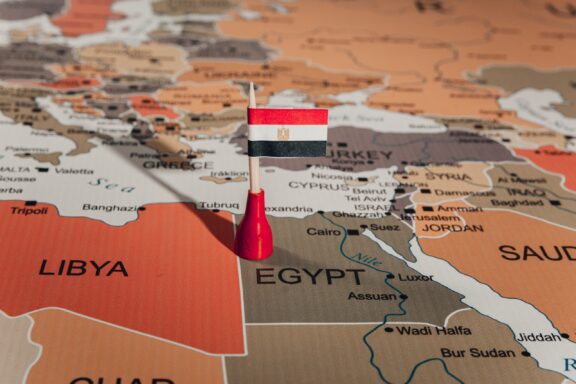
The DMS (Degrees, Minutes, Seconds) coordinates for the center of Egypt are:
- 26° 49′ 13.99” N
- 30° 48′ 8.99” E
The latitude and longitude of Egypt are:
- Latitude: 26.820553
- Longitude: 30.802498
You can see the location of Egypt on the world map below:
Egypt Neighboring Countries
Egypt shares borders with four other nations, two of which are in Africa, and two of which are in the Middle East. The longest foreign land border is shared between Egypt and Sudan, between whom there are ongoing tensions. These tensions have led to a disputed border area called the Halayeb Triangle.
The neighboring countries of Egypt (EG) are:
Maritime Borders
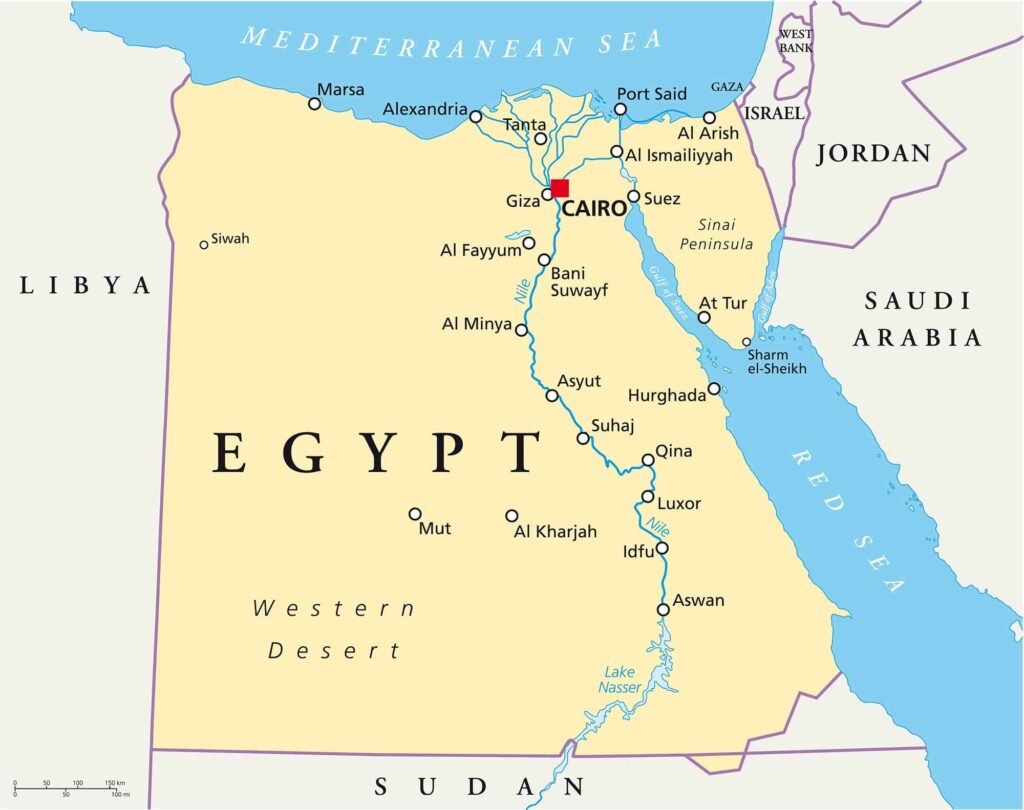
Egypt borders both the Mediterranean Sea and the Red Sea. The artificial Suez Canal connects these two seas and plays a major role in facilitating trade between Europe and Asia.
Egypt Interesting Facts
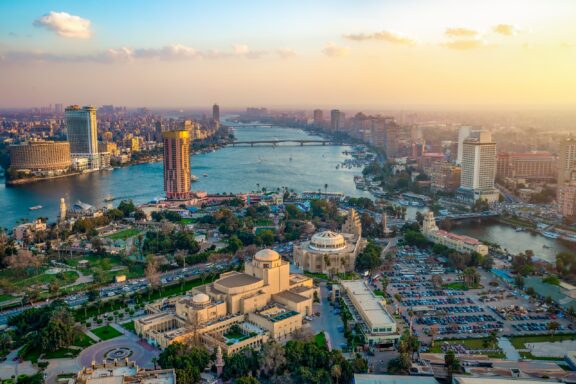
- Egypt is home to the Nile, the longest river in the world.
- Hieroglyphics, one of the first writing systems ever developed, originated in ancient Egypt.
- Cairo is the biggest city in Africa and is sometimes called the “City of a Thousand Minarets” for its abundance of Islamic architecture.
Administrative Divisions of Egypt
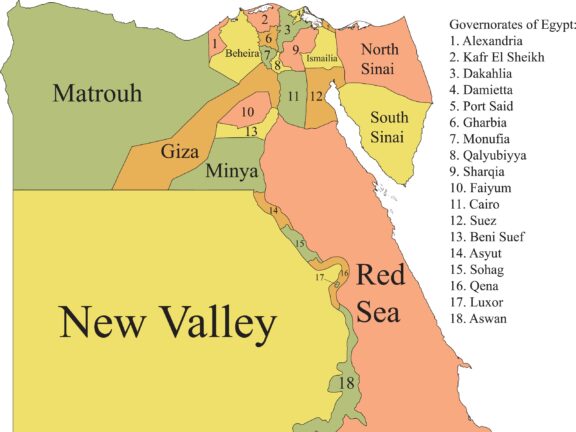
Egypt is divided into 27 governorates as the largest administrative divisions in the country. Each of these has a capital city and is further divided into regions, which contain towns and villages.
The most populous governorate in the country is Cairo, which is home to the capital of Egypt and is located at the southern end of the Nile Delta. The largest governorate, covering an area of 440,098 km2 (169,922.8 square miles), is New Valley, which is also the least densely populated governorate.
Geography of Egypt
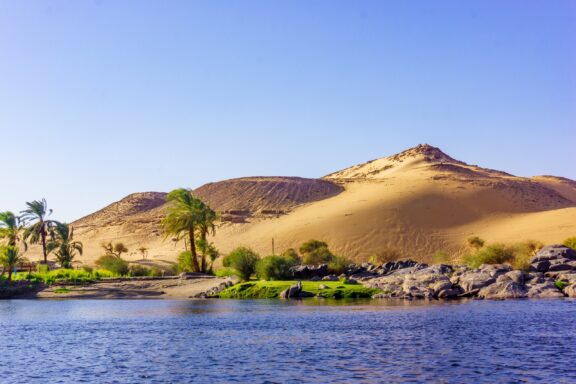
The geography of Egypt is distinct. The country consists of an immense area of uninhabitable desert, crossed by the longest river in the world, the Nile. It also has long coastlines along its northern and eastern borders.
The Nile River flows from south to north while it traverses the country, creating a fertile valley and a large delta where it meets the Mediterranean Sea. This delta has been the heart of Egyptian civilization for thousands of years because of its rich soils and freshwater access, a sharp contrast to the arid landscapes of the Sahara Desert that dominate the rest of the country.
Egypt’s Sinai Peninsula extends northeast into Southwest Asia, making the country a transcontinental nation. Both geographically and culturally, Egypt belongs to two continents: Africa and Western Asia. This strategic position between two continents has helped to provide Egypt with an important geopolitical role in the region and the world.
First opened in 1869, the Suez Canal connects the Mediterranean and Red Seas, forming an essential link for trade between Europe and Asia.
History of Egypt
It would be impossible to talk about Egypt’s history without mentioning one of the most powerful and longest-standing civilizations in the world’s history — Ancient Egypt. The civilization lasted for over 3,000 years, starting around 3100 BCE, and was marked by stability and remarkable achievements in various fields such as arts, sciences, mathematics, and writing.
It was in ancient Egypt that many monumental structures were created that are still standing today. These include pyramids, temples, tombs, and more. Mysteries surround the construction methods used to build some of these sites, and they’re still some of the most popular tourist attractions in the world.
During the late period of ancient Egypt, invasions from Persia and Assyria were frequent. Eventually, Alexander the Great conquered Egypt in 332 BCE, which marked the beginning of the Ptolemaic Dynasty. Queen Cleopatra would be the last ruler of this dynasty until her dramatic death in 332 BCE.
After Cleopatra’s death, Egypt became a province of the Roman Empire, remaining under Roman and then Byzantine control until the 7th century CE, when it was invaded and conquered by the Arab Muslims. Islam and the Arabic language were introduced and became widespread in Egypt during this time.
Egypt was then ruled by the Ottoman Turks and other foreign powers for centuries before becoming a British protectorate in 1882 and finally gaining independence in 1952. The first President of the Republic of Egypt was General Muhammad Naguib, who took office in 1953.
The recent history of Egypt is marked by political upheaval, including several wars with neighboring Israel, a brief period as part of the United Arab Republic, and the Egyptian Revolution in 2011, which led to the resignation of then-president Hosni Mubarak.
Today, Egypt remains a significant cultural, political, and military power in the Middle East and North Africa despite continuing political and economic challenges.
Culture and People of Egypt
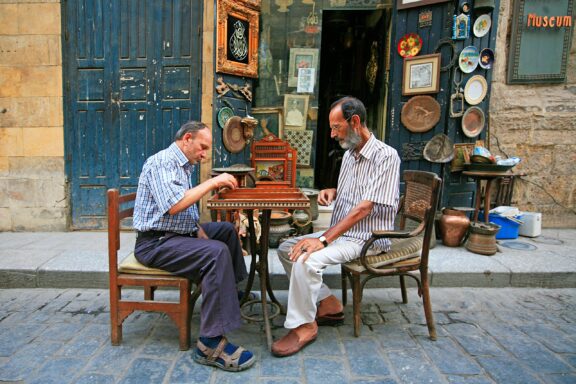
People
With an estimated 2023 population of almost 110 million, Egypt is the 15th-most populated country in the world and has the highest population in the Arab world. The ethnic makeup of the country is fairly homogeneous, with more than 99% of the population being ethnic Egyptian.
Modern Standard Arabic (MSA) is the official language of the Republic, and the most spoken varieties of Arabic are Egyptian Arabic and Sa’idi Arabic. English and French are also widely studied as foreign languages.
The state religion as defined in the Constitution of Egypt is Islam, and the country has the sixth-largest Muslim population in the world. It also has the highest population of Christians in the Middle East and North Africa.
Cuisine

Due to its location, Egyptian cuisine is characterized by influences from other cultures. These influences have taken place over centuries and have come from the Greek, Ottoman Turkish, and Levantine cultures.
Staple foods include lentils, rice, pasta, and a variety of fruits and vegetables. Bread, particularly aish baladi, which is similar to pita bread, is a major part of every meal. Dishes often feature legumes and vegetables alongside meats like lamb, chicken, and rabbit.
The most famous dish in the country is likely kushari, a comforting mixture of rice, lentils, chickpeas, and macaroni, topped with a spicy tomato sauce, caramelized onions, and sometimes a sprinkle of garlic juice and vinegar.
Arts
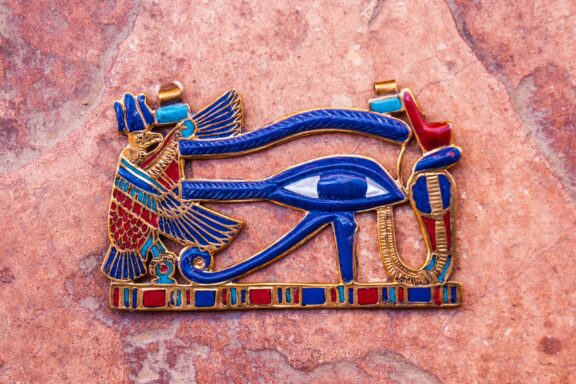
Art and literature in Egypt both trace their origins back to antiquity, with significant advancements made in ancient Egypt in both fields. Some of the best art museums in the country today are the Museum of Islamic Art and the Mahmoud Mukhtar Museum, both of which are in Cairo.
The cinema and music industries in Egypt are highly influential throughout the Arab world, and Egypt is often considered the home of belly dance.
Biggest Cities in Egypt
Here are the largest cities in Egypt based on 2021 data:
| City | Population |
|---|
| Cairo | 19,787,000 | Giza | 5,598,402 | Alexandria | 4,870,000 | Shubra al Khaymah | 1,025,569 | Al Mansurah | 960,423 | Halwan | 619,293 | Port Said | 524,433 | Suez | 516,959 | Tanta | 429,503 | Asyut | 389,307 |
Map of Egypt with the Largest Cities
Egypt Economy Facts
| World Bank Income Group | Lower middle incom |
| World Bank Region | Middle East & North Africa |
| Currency | Egyptian Pound (EGP) |
| GDP in 2020 | $365.3 (billions of USD) World Rank: 32 |
| GDP per capita in 2020 | $3,569 World Rank: 123 |
| Major Industries / Economic Sectors | Agriculture, manufacturing, energy, services |
| Top 5 Import Countries | China, United States, Russia, Germany, Italy |
| Top 5 Export Countries | United States, Italy, Saudi Arabia, Turkey, India |
Government and Politics in Egypt
Egypt is a unitary, semi-presidential republic, where the President is the head of state and the Prime Minister is the head of government. There are also two legislative bodies: the House of Representatives, which is the lower house, and the Senate, the upper house. The judiciary is independent, with the Supreme Constitutional Court being the highest judicial authority.
The current President of Egypt is Abdel Fattah el-Sisi, who came to power following the 2013 coup that ousted President Mohamed Morsi. El-Sisi’s government has been noted for its authoritarian leanings and has also undertaken significant economic reforms and infrastructure projects.
Tourist Attractions of Egypt
Tourism is one of the most important sectors of the Egyptian economy. There are plenty of amazing experiences in Egypt for travelers to enjoy, whether it’s visiting an ancient pyramid, exploring the desert, or diving in the Red Sea. Read on to learn about some of the top things to do in Egypt.
Pyramids of Giza
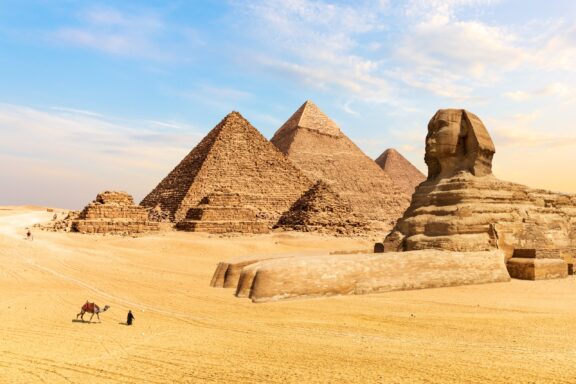
The Giza Pyramid Complex is one of the most famous wonders on the planet and a UNESCO World Heritage Site. This is where the iconic Great Sphinx is located, and it’s one of the most-visited sites in Egypt.
Luxor
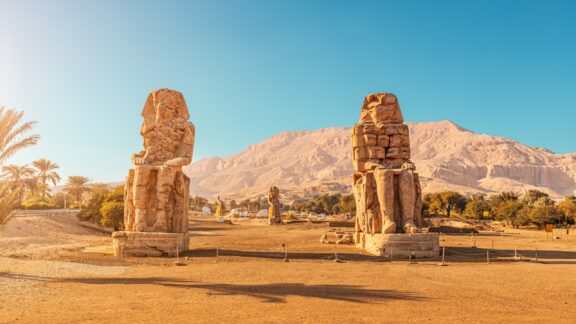
Luxor, Egypt is home to so many tombs and temples that it has been called the “largest open-air museum in the world.” Most of the historical attractions of the city are located on the western bank of the Nile, while the city on the eastern side of the Nile is modern and home to several museums.
Red Sea Diving
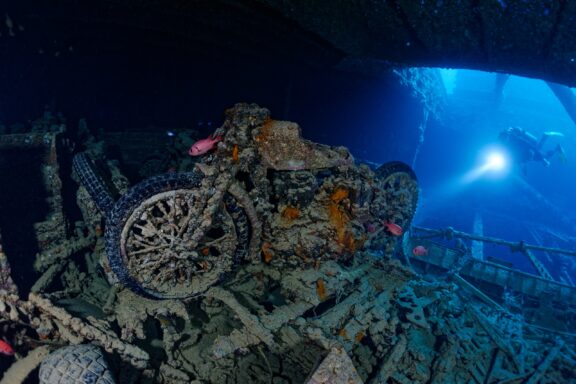
The Red Sea offers some of the best diving in the world. Abundant marine life paired with exceptionally clear waters makes for excellent diving conditions, and several shipwrecks are an additional attraction. The Thistlegorm, a British cargo ship from World War II, is the most famous wreck.
Transportation and Infrastructure of Egypt
The easiest way to travel to Egypt, by far, is by plane. Fortunately, the country is well served by many international airlines, many of which fly direct to Egypt from around the world. The main international airports in Egypt are in Cairo, Alexandria, Sharm el Sheikh, Luxor, Marsa Alam, and Asam.
Arriving in Egypt by road is impractical due to bureaucracy at border points, though there are plans for a high-speed rail link between Egypt and Sudan.
It is also possible to take ferries between Jordan and Egypt or along the Nile between Sudan and Egypt.
Once inside the country, travel can be done via airplane, bus, taxi, or train. Between cities, traveling by air is the most convenient option, and EgyptAir offers many in-country flights.
Climate and Weather of Egypt
The Egyptian climate is characterized by hot, dry summers and mild winters. With the exception of the Mediterranean coastal region, which receives slightly more precipitation, the country sees very little rainfall.
The summer temperatures in the inland desert can be extremely high, often exceeding 40°C (104°F), while winter temperatures can drop significantly at night. Areas along the Nile River and the Mediterranean coast generally have a more moderate and comfortable climate.
Egypt Related Content
Egypt Key Facts
| World Bank Income Group | Lower middle income |
| World Bank Region | Middle East & North Africa |
| Currency | Egyptian Pound (EGP) |
| GDP in 2020 | $365.3 (billions of USD) World Rank: 32 |
| GDP per capita in 2020 | $3,569 World Rank: 123 |
| Major Industries / Economic Sectors | Agriculture, manufacturing, energy, services |
| Top 5 Import Countries | China, United States, Russia, Germany, Italy |
| Top 5 Export Countries | United States, Italy, Saudi Arabia, Turkey, India |
Image Sources and Copyright Information
- Egyptian Flag Pin on Map Indicating Egypt’s Location: © GR.Stocks/Shuttesrtock
- Sunset Over Cairo: A Panoramic View of the Bustling Cityscape and the Nile River: © givaga/Shutterstock
- Color-Coded Map of Egypt’s Governorates with Labels: © vectorissimo/Shutterstock
- Serene View of the River Nile with Lush Greenery and Sand Dunes in Egypt: © Ewa Studio/Shutterstock
- Two Men Playing a Board Game in Khan El-Khalili District, Cairo, Egypt: © Eric Valenne geostory/Shutterstock
- Traditional Egyptian Kushari Dish with Lentils, Rice, Pasta, and Crispy Onions: © Dina Saeed/Shutterstock
- Colorful Lapis Lazuli Eye of Horus Pendant with Enamel Detailing on a Stone Background: © Daria Volyanskaya/Shutterstock
- Camel Rider by the Great Sphinx and Pyramids of Giza at Sunset: © AlexAnton/Shutterstock
- Sunlit View of the Colossi of Memnon in Egypt: © frantic00/Shutterstock
- Scuba Divers Exploring a Sunken Motorcycle Wreck in the Red Sea: © Kimmo Hagman/Shutterstock